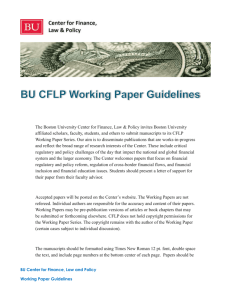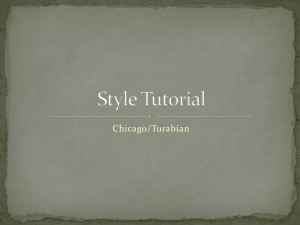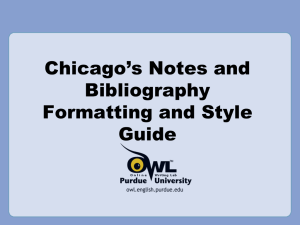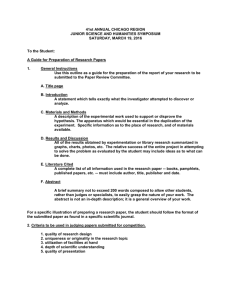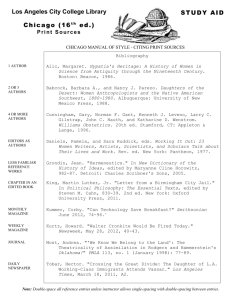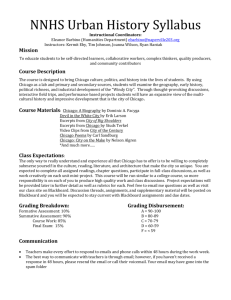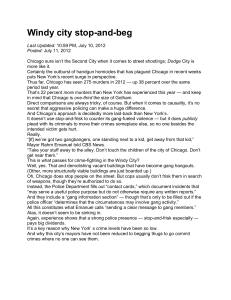Chicago Manual of Style (or, Turabian)
advertisement
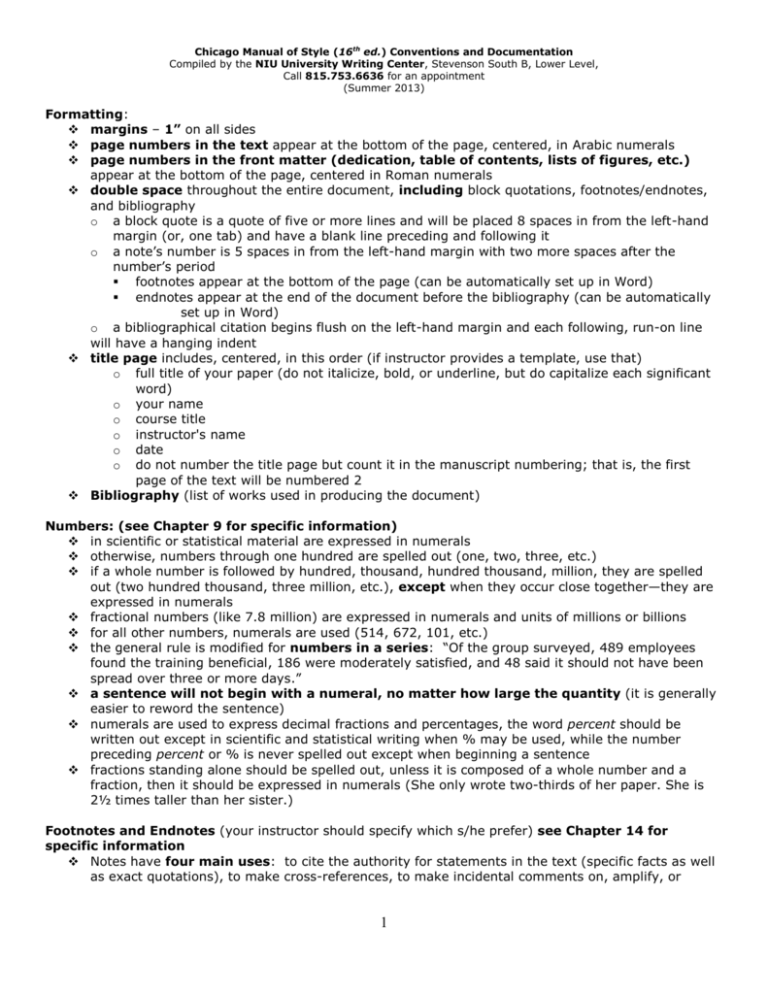
Chicago Manual of Style (16th ed.) Conventions and Documentation Compiled by the NIU University Writing Center, Stevenson South B, Lower Level, Call 815.753.6636 for an appointment (Summer 2013) Formatting: margins – 1” on all sides page numbers in the text appear at the bottom of the page, centered, in Arabic numerals page numbers in the front matter (dedication, table of contents, lists of figures, etc.) appear at the bottom of the page, centered in Roman numerals double space throughout the entire document, including block quotations, footnotes/endnotes, and bibliography o a block quote is a quote of five or more lines and will be placed 8 spaces in from the left-hand margin (or, one tab) and have a blank line preceding and following it o a note’s number is 5 spaces in from the left-hand margin with two more spaces after the number’s period footnotes appear at the bottom of the page (can be automatically set up in Word) endnotes appear at the end of the document before the bibliography (can be automatically set up in Word) o a bibliographical citation begins flush on the left-hand margin and each following, run-on line will have a hanging indent title page includes, centered, in this order (if instructor provides a template, use that) o full title of your paper (do not italicize, bold, or underline, but do capitalize each significant word) o your name o course title o instructor's name o date o do not number the title page but count it in the manuscript numbering; that is, the first page of the text will be numbered 2 Bibliography (list of works used in producing the document) Numbers: (see Chapter 9 for specific information) in scientific or statistical material are expressed in numerals otherwise, numbers through one hundred are spelled out (one, two, three, etc.) if a whole number is followed by hundred, thousand, hundred thousand, million, they are spelled out (two hundred thousand, three million, etc.), except when they occur close together—they are expressed in numerals fractional numbers (like 7.8 million) are expressed in numerals and units of millions or billions for all other numbers, numerals are used (514, 672, 101, etc.) the general rule is modified for numbers in a series: “Of the group surveyed, 489 employees found the training beneficial, 186 were moderately satisfied, and 48 said it should not have been spread over three or more days.” a sentence will not begin with a numeral, no matter how large the quantity (it is generally easier to reword the sentence) numerals are used to express decimal fractions and percentages, the word percent should be written out except in scientific and statistical writing when % may be used, while the number preceding percent or % is never spelled out except when beginning a sentence fractions standing alone should be spelled out, unless it is composed of a whole number and a fraction, then it should be expressed in numerals (She only wrote two-thirds of her paper. She is 2½ times taller than her sister.) Footnotes and Endnotes (your instructor should specify which s/he prefer) see Chapter 14 for specific information Notes have four main uses: to cite the authority for statements in the text (specific facts as well as exact quotations), to make cross-references, to make incidental comments on, amplify, or 1 qualify textual discussion i.e. information that the writer deems important, but might otherwise disrupt the flow of the paper, and to make acknowledgements. To insert a footnote/endnote (in Word): select “Insert” from the top menu, select “Reference,” a window will appear and you will select either “Footnote” (bottom of page) or “Endnote” (end of document). This will automatically superscript the footnote/endnote number in the text and set the footnote/endnote number (not superscripted) at the bottom of the page or on the endnotes page. Notes are double spaced (both in the entries and between the notes). Notes are formatted as seen below. The first time a work is mentioned in a note, the entry should be in complete form; that is, it should include not only the author’s full name, the title of the work, and the specific reference, but the facts of publications as well. Once a work has been cited in full, subsequent references to it should be in a shortened form such as short titles or ibid. o Ibid. is used when references to the same work follow one another with no intervening references, even if the reference is separated by several pages. 1.Max Plowman, An Introduction to the Study of Blake (London: Gollancz, 1982), 32. 2.Ibid. 3.Ibid., 68. o (This reference is the same author, same text, same everything as the previous note, but a different page number.) A shortened reference occurs when a source is repeated, but is not sequential. A title should be shortened to its key words if it is six or more words: The Essential Tension: Selected Studies in Scientific Tradition and Change to Essential Tension. 1.Max Plowman, An Introduction to the Study of Blake (London: Gollancz, 1982), 32. 2.Abdul al-Achmad, Immunization and Chemotherapy (Chicago: Blitzstein, 1994), 247. 3.Plowman, Study of Blake, 125. (This type is used when there is more than one source by an author.) 4.Al-Achmad, 382. (This type is used when there is only one book by an author.) For works with 1-3 authors, use all names each time in the order they appear on the title page. For works with 4-10 authors, use the first name and et al. For the bibliography, use all of the names. For works with more than 10 authors, use the first seven and then et al. in the bibliography. Indirect source/Citation taken from a Secondary Source (if you are using a quotation that appeared in a source you are using—in other words, not the original quotation, but a quotation of a quotation) References to the work on one author as quoted in that of another must cite both works: Louis Zukofsky, “Sincerity and Objectification,” Poetry 37 (February 1931): 269, quoted in Bonnie Costello, Marianne Moore: Imaginary Possessions (Cambridge: Harvard University Press, 1981), 78. If the purpose of such a reference is to emphasize the secondary author’s quoting of the original work, use the following style: 2. Bonnie Costello, Marianne Moore: Imaginary Possessions (Cambridge: Harvard University Press, 1981), 78, quoting Louis Zukofsky, “Sincerity and Objectification,” Poetry 37 (February 1931): 269. Titles (see Chapter 8 for more specific examples) Italicize titles of independently published works: books, pamphlets, bulletins, periodicals (magazines, journals, newspapers), and long poems (such as Paradise Lost). If the work bears a publisher’s imprint (i.e. has a publisher), the title should be italicized. o Other titles that should be italicized include legal cases, plays, films, radio/television programs, ships and aircraft, and foreign words. Quotation marks are used for titles of works published within larger works: titles of chapters, short stories, short poems, essays, and articles in periodicals o Other titles that should be placed within quotation marks include episodes of television/radio programs, songs on an album, scenes in films, and titles of unpublished theses, dissertations, or other papers Capitalization for titles mentioned in text or notes follow headline style – The Joy of Using Chicago Citation Guidelines: A Adventure in Documentation) 2 Sample Entries for Footnotes/Endnotes and Bibliography (See Chapter 14 for specific information) All entries should be listed alphabetically by author. *Bibliographies are double spaced with one blank line between entries. The first line is flush left and then all subsequent lines have a hanging indent.* This is meant to be a basic guide. Often, types are hybridized. Book with one author Book with two authors N 1. John Hope Franklin, George Washington Williams: A Biography (Chicago: University of Chicago Press, 1985), 54. B Franklin, John Hope. George Washington Williams: A Biography. Chicago: University of Chicago Press, 1985. N 1. Robert Lynd and Helen Lynd, Middletown: A Study in American Culture (New York: Harcourt, Brace and World, 1929), 67. B Lynd, Robert and Helen Lynd, Middletown: A Study in American Culture. New York: Harcourt, Brace and World, 1929. 1. Book with anonymous/no author N B The Lottery. London: J. Watts, 1931. Work in an anthology/Chapter in Book N 1. Hannah Betts, "The Image of this Queene so Quaynt: The Pornographic Blazon," in Dissing Elizabeth: Negative Representations of Gloriana, ed. Julia M. Walker (Durham: Duke University Press, 1998), 153-184. B Betts, Hannah. "The Image of this Queene so Quaynt: The Pornographic Blazon 1588-1603." In Dissing Elizabeth: Negative Representations of Gloriana, edited by Julia M. Walker, 153-184. Durham: Duke University Press, 1998. N 1. Robert von Hallberf, ed., Cannons (Chicago: University of Chicago Press, 1984), 225. B von Hallberf, Robert, ed. Cannons. Chicago: University of Chicago Press, 1984. N 1. American Library Association, Young Adult Services Division, Services Statement Development Committee, Directions for Library Service to Young Adults (Chicago: American Library Association, 1978), 25. B American Library Association, Young Adult Services Division, Services Statement Development Committee. Directions for Library Services to Young Adults. Chicago: American Library Association, 1978. N 1. The Complete Works of Samuel Taylor Coleridge, ed. W. G. T. Shedd, vol. 1, Aids to Reflection (New York: Harper & Bros., 1884), 18. B Coleridge, Samuel Taylor. The Complete Works of Samuel Taylor Coleridge. Edited by W. G. T. Shedd. Vol. 1, Aids to Reflection. New York: Harper & Bros., 1884. 1. Ellen Pollak, The Poetics of Sexual Myth: Gender and Ideology in the Verse of Swift and Pope, Women in Culture and Society (Chicago: University of Chicago Press, 1985), 124. Editor or Compiler as Author Institution or Association listed as author Author’s Work Contained in Collected Works Book in a Series Article in a journal with volume Article in a magazine N The Lottery (London: J Watts, 1931), 20-25. B Pollak, Ellen. The Poetics of Sexual Myth: Gender and Ideology in the Verse of Swift and Pope. Women in Culture and Society. Chicago: University of Chicago Press, 1985. N 1. Lawrence P. Smith, “Sailing Close to the Wind,” Politics in Action 10, no. 4 (1993): 82, 99-100. B Smith, Lawrence P. “Sailing Close to the Wind.” Politics in Action 10, no. 4 (1993): 80-102. N 1. Bruce Weber, “The Myth Maker: The Creative Mind of Novelist E. L. Doctorow,” New York Times Magazine, 20 October 1985, 42. 3 B Article in a newspaper Weber, Bruce. “The Myth Maker: The Creative Mind of Novelist E. L. Doctorow.” New York Times Magazine, 20 October 1985, 42-6. 1. N Irish Daily Independent (Dublin), 16 June 1904. News items from gaily papers are rarely listed separately in a bibliography or reference list. Published Interview N 1. John Fowles, “A Conversation with John Fowles,” interview by Robert Foulke (Lyme Regis, 3 April 1984), Salmagundi, nos. 68-69 (fall1985-winter 1986): 370. B Fowles, John. “A Conversation with John Fowles.” Interview by Roert Foulke (Lyme Regis, 3 April 1984). Salmagundi, nos. 68-69 (fall 1985-winter 1986): 367-84. Unpublished Interview N Generally, the information only appears in a note and is not usually in the bibliography 1. Benjamin Spock, interview by Milton J. E. Senn, 20 November 1974, interview 67A, transcript, Senn Oral History Collection, National Library of Medicine, Bethesda, Md. B Spock, Benjamin. Interview by Milton J. E. Senn, 20 November 1974. Interview 67A, transcript. Senn Oral History Collection, National Library of Medicine, Bethesda, Md. Thesis or Dissertation N 1. Gilberto Artioli, “Structural Studies of the Water Molecules and Hydrogen Bonding in Zeolites” (Ph.D. diss., University of Chicago, 1985), 10. B Sound Recordings Online Journal Article N 1. B Mailer, Norma. The Naked and the Dead. Recorded March 1983. Caedmon CP1619, 1983. 2 compact discs. N 1. Kira Sanbonmatsu, “Gender Stereotypes and Vote Choice,” American Journal of Political Science 46 (2002), 21-22, accessed March 22, 2004, http://www.jstor.org/ view/00925853/sp030001/03x0054b/0#&origin=sfx3Asfa. B Online magazine article Artioli, Gilberto. “Structural Studies of the Water Molecules and Hydrogen Bonding in Zeolites.” Ph.D. diss., University of Chicago, 1985. ProQuest (AAT 409234). N Norman Mailer, The Naked and the Dead, excerpts read by author, recorded March 1983, Caedmon CP1619, 1983, compact discs. Sanbonmatsu, Kira. “Gender and Stereotypes and Vote Choice.” American Journal of Political Science 46 (2002): 200-34, Accessed March 22, 2004. http://www.jstor.org/view/00925853/sp030001/03x0054b/ 0#&origin=sfx3Asfa. 1. Eric Boehlert, "Watch Your Mouth," Salon, March 19, 2004, http://www.salon.com/news/feature/2004/03/19/fcc/. B Boehlert, Eric. "Watch Your Mouth." Salon, March 19, 2004, Accessed March 22, 2004, http://www.salon.com/news/feature/2004/03/1/fcc/. N 1. Tanya Schevitz, "Berkeley Parents Reinvent School: Charter Program to Focus on Ability Rather Than Age," San Francisco Examiner, January 18, 1995, Wednesday; fourth edition, http://web.lexis-nexis.com/universe/ document?_m=5b81f9bb972aef2e8ed34751f6d3002f&_docnum=16& wchp=dGLbVlb-zSkVA&_m d5=a7ced40274280aa4a3ac6bed4cd2a53a (accessed March 22, 2004). Downloaded Book N Does not generally have stable page numbers, so use the chapter. 1. Austin, Jane. Pride and Prejudice (New York: Penguin Classics, 2007), Kindle edition, chap. 5. B Newspaper article online News items from daily newspapers are rarely listed in a bibliography or reference list, unless the newspaper is referred to several times and constitutes a substantial part of the documentation. Book Consulted Online N Austin, Jane. Pride and Prejudice. New York: Penguin Classics, 2007. Kindle edition. 1. Emma Hardinge Britten, Modern American Spiritualism: A Twenty Years' 4 Record of the Communion Between Earth and the World of Spirits, (New York: The Author, 1870): 57, Making of America Collection, http://www.hti.umich.edu/cgi/t/text/text-idx?c=moa;idno=ACM3377. You do not need to include an access date. B Britten, Emma Hardinge. Modern American Spiritualism: A Twenty Years' Record of the Communion Between Earth and the World of Spirits. New York: The Author, 1870. Making of America Collection, http://www.hti.umich.edu/ cgi/t/text/text-idx?c=moa;idno=ACM3377. Website N The access date is not necessary unless there is no date of publication or revision or if it is a field that is subject to change. 1. Evanston Public Library Board of Trustees, “Evanston Public Library Strategic Plan, 2000-2010: A Decade of Outreach,” Evanston Public Library, last modified March 18, 2009, http://www.epl.org/library/strategic-plan-00.html (accessed July 18, 2002). B Evanston Public Library Board of Trustees. “Evanston Public Library Strategic Plan, 2000-2010: A Decade of Outreach.” Evanston Public Library. Last modified March 18, 2009. http://www.epl.org/library/strategic-plan00.html. 5 Sample Entries for In-text citations and Reference List (See Chapter 15 for specific information) All entries should be listed alphabetically by author. *Bibliographies are double spaced with one blank line between entries. The first line is flush left and then all subsequent lines have a hanging indent.* This is meant to be a basic guide. Often, types are hybridized. In-text citations (in-text author-date reference) Used by physical, natural and social sciences Parallels much of the footnote/endnote format (author’s/authors’ last name(s) publication date) Page numbers are used if the information is from a particular passage in the original work o NOTES: 1. no punctuation is used between the components in the parentheses if just name and date; 2. A comma is used between the publication date and a page number (Johnson 2011) or (Johnson 2011, 18) or (Johnson and Jones 2012, 442) Uses a Reference or Works Cited page instead of Bibliography May use in conjunction with information-based footnotes/endnotes Book with one author Book with two authors In-text (Franklin 1985, 34) R Franklin, John Hope. 1985. George Washington Williams: A Biography. Chicago: University of Chicago Press. In-text (Lynd and Lynd 1929, 67) R Lynd, Robert and Helen Lynd. 1929. Middletown: A Study in American Culture. New York: Harcourt, Brace and World. In-text (Betts 1998, 153) R Betts, Hannah. 1998. "The Image of this Queene so Quaynt: The Pornographic Blazon 1588-1603." In Dissing Elizabeth: Negative Representations of Gloriana, 153-184. Durham: Duke University Press. In-text (Smith 1993, 82) R Smith, Lawrence P. 1993. “Sailing Close to the Wind.” Politics in Action 10 (4): 80-102. Article in a magazine In-text (Weber 1985, 42) News items from magazines are rarely listed separately in a reference list. R Weber, Bruce. 1985. “The Myth Maker: The Creative Mind of Novelist E. L. Doctorow.” New York Times, 20 October, 42-6. Online Journal Article R Smith, Lawrence P. 1993. “Sailing Close to the Wind.” Politics in Action 10 (4): 80-102. http://www.politicalwebsite.com Website R Evanston Public Library Board of Trustees. 2009. “Evanston Public Library Strategic Plan, 2000-2010: A Decade of Outreach.” Evanston Public Library. Last modified March 18. http://www.epl.org/library/strategic-plan-00.html. Work in an anthology/Chapter in Book Article in a journal The access date is not necessary unless there is no date of publication or revision or if it is a field that is subject to change. 6
